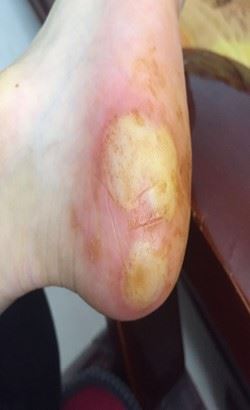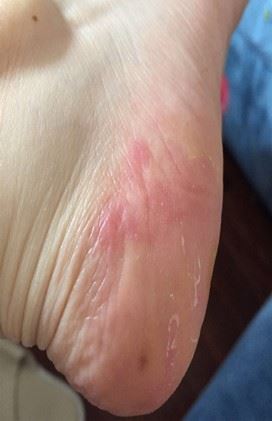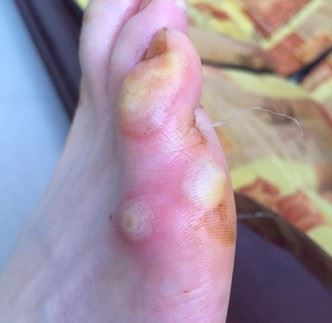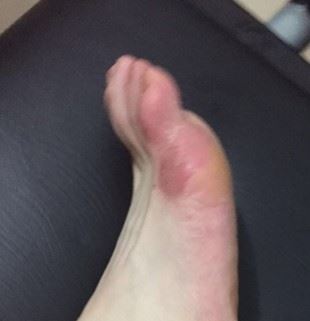Authors:
Liyan Zhang (Registered Nurse) 1; Jieyuan Cai (Master Student) 1; Hong Sun (Doctor of Medication) 2; Lin Shen (Doctor of Medication) 1
1 The Key Laboratory of Carcinogenesis and Translational Research (Ministry of Education), Department of GI Medical Oncology, Peking University School of Oncology, Beijing Cancer Hospital & Institute, Beijing, China 2 Department of Intergrative Medicine & Geriatric Oncology, Peking University School of Oncology, Beijing Cancer Hospital & Institute, Beijing, China;
*Corresponding author: Hong Sun
Regorafenib is a novel, oral anticancer agent used in cancer treatment. Despite its known benefit in improving survival among cancer patients, it was reported to induce hand–foot skin reaction (HFSR) in patients . HFSR is characterised by numbness, tingling sensation, swelling, desquamation, ulceration, hyperkeratinized or pain in hands and feet. It significantly affects the quality of life (QOL) of patients, even upon dose reductions or treatment discontinuation. Currently, the methods for managing HFSR include moisturization, avoiding friction or chemical injury, or drug dose adjustment, although these treatments have limited efficacy. Traditional Chinese medicine (TCM) is useful in skin-related symptoms by regulating internal imbalance, promoting skin wound healing, relieving pain, anti-inflammatory. However, there is no clinical studies to confirm the effect of TCM in alleviating HSFR.
In view of this, we conducted a study that aimed to investigate whether a compound traditional Chinese medicine (CTCM) oil would alleviate HFSR induced by regorafenib, in order to enhance the physical function and quality of life of cancer patients on a regorafenib treatment regime.
The study involved 85 patients with metastatic colorectal cancer presenting with HFSR. These patients were divided into the control group (n = 42) and the intervention group (n = 43). The HFSR among the control participants was managed as keeping skin moisture, avoiding friction or chemical injury and using pain killers or other medication following doctors’ order. The intervention participants was treated with a CTCM oil comprising five selected herbs which can alleviate skin swelling, pain, injury anti-inflammatory, eventually promoting skin repair and wound healing . This oil generally works by regulating immune functions and the molecular pathways leading to inflammation. The oil was given to the intervention participants for external application twice daily for two weeks. To evaluate the effect of the application of this CTCM oil, we compared the HFSR remission rate and quality of life (QOL) between the two groups of participants at post-intervention (two weeks after the start of intervention).
Our data support that CTCM oil application is effective in the treatment of HSFR and improving the well-being of the patients. Notably, the post-intervention HFSR remission rate was significantly higher among participants in the intervention group than those in the control group (65.1% vs 16.7%; p < 0.01) indicating that the use of the CTCM oil can alleviate the severity of HFSR among the patients. Consistent with this, participants in the intervention group also experienced lower levels of pain caused by the inflammatory events associated with HFSR (p < 0.01). Besides, the oil significantly improved patients’ physical function such as walking and grabbing stuffs, emotional function as depression and the social function as social activities. (p < 0.05). Overall, our data demonstrated that the CTCM oil can effectively alleviate HFSR and improve the QOL of patients using regorafenib.
The findings suggest the CTCM oil can be considered as an optional management of patients undergoing therapy with regorafenib. Future research may explore the efficacy of CTCM oil in reliving other skin conditions.


Before CTCM oil application After CTCM oil application


Before CTCM oil application After CTCM oil application
Figure 1. HRSR before and after intervention
Note: Before treatment, both patients’ feet occur HFSR, presenting as skin hyperkeratinized (as yellow part shown), swelling and severe pain, affect their walking badly. After treatment, the symptoms significantly relieved.
This study was presented at ICCN2022 virtual conference.
Registration for ICCN2022 virtual library now open. For more information, please access https://www.iccn2022.com/registration/